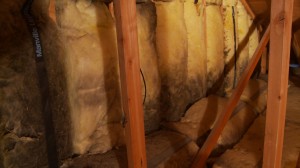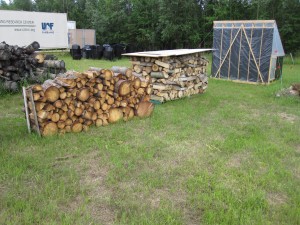Although mold can’t be ruled out, it is quite probable that it may be caused by something else.
Just because you have dark spots on your insulation doesn’t mean you have a festering mold problem. Air leakage from inside the house through the walls and ceilings can produce some pretty dramatic localized black spots in fiberglass batts. Typically, fiberglass batting isn’t good at stopping air leakage, but it does act as a very effective filter material for airborne dust particles. Dirty insulation is a phenomenon that is especially common in older, leaky houses in the Interior.
In a recent attic inspection of a 30-year-old home, CCHRC found batt insulation riddled with dark streaks. The source of the streaking was a lot of air leakage through electrical outlets, wiring penetrations, gaps in the vapor retarder, gaps around furnace ducting, chimney, and other sources.
Particulates released by combustion appliances, such as wood stoves, boilers, furnaces, diesel heaters or auto exhaust, can produce very fine soot that can build up over time in insulation. Tobacco smoke can also contribute.
Look for clues in the pattern of the dark stuff. Does it match up with an air leakage pathway? For example, air from inside the home can exit through an unsealed electrical penetration in the ceiling and follow the wiring through the insulation, depositing dirt in the surrounding fiberglass along the way.
Does the wood framing or sheathing around the insulation also have black spots? If not, it is more indicative of dirt than mold.
If you are still concerned that you may have a mold problem, call a mold expert to make a positive identification.

